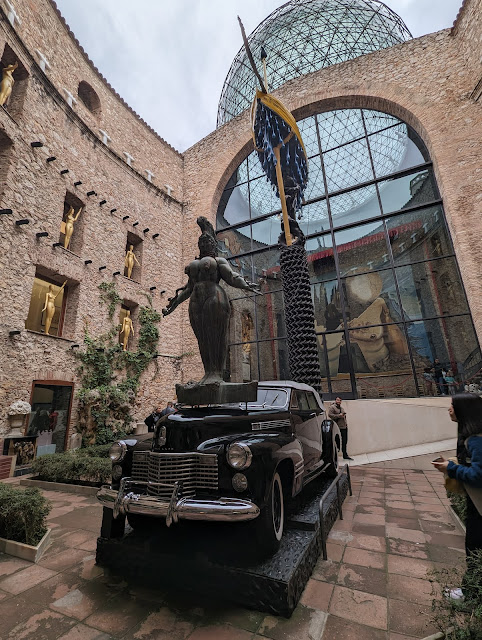During the 1960s, the mayor of Figueres, Salvador Dali's birthplace in Catalonia, asked if the artist would like to donate one of his works to the town's museum. Dali instead suggested creating a new museum for dozens of pieces he would donate, inside the space of the town's municipal theater, which had been badly damaged by air raids during Spain's Civil War, with only its perimeter walls surviving. Dali liked the location because it had housed the first-ever public exhibit of his work, long before the war. He also suggested including works by other Surrealists, and worked tirelessly on the design for the museum until it was finally open to the public in 1974. The exterior parapets of the radically reconfigured Teatro-Museo included a series of large sculptural eggs to complement an airy interpretation of a geodesic dome by architect Emilio Pérez. Why eggs, you may be wondering. Well, why not eggs?
Dali had enthusiastically adopted the automobile, and featured cars in his paintings as early as 1924. Cadillacs from the 40s would also figure in Dali paintings with titles like "Clothed Automobiles" and "Dressed Automobiles". They were paintings of 1941 Cadillacs that were, sure enough, wearing clothes. It appears that General Motors never took up the challenge of using them in their advertising program, though. It is not surprising, then, that Dali decided that a good focus for the museum courtyard would be provided by the Cadillac Series 62 that he'd gifted to his wife Gala...
And of course, it wasn't just any Cadillac Series 62, but a four-door convertible, one of around 400 built in the last year for that body style, 1941, two years after the end of the Spanish Civil War, in which Dali stayed neutral, and in which Pablo Picasso sided with the Republicans*. The installation called "The Rainy Cadillac" was said to have been inspired by a piece called "Rainy Taxi" exhibited by Dali in Paris in 1938. Like that piece, the courtyard Cadillac has two occupants, but here the chauffeur is not a shark, and there's some greenery to keep the driver and passenger company. And a watering system to fog up the windows, because this is, after all, "The Rainy Cadillac."
It's all in the "waking dream" spirit of Surrealism, and the Dali Museum in Figueres is said to be the most all-encompassing surrealist object made by the artist, as he spent time on every detail, including the sculptures in the courtyard windows reflected in the glass below...
Other than than being a 4-door convertible, the Dali Caddy was like others of its era, with a 346 cubic-inch L-head V8, independent front suspension and hydraulic brakes when Ford (and some English car makers) still favored mechanical ones. 1941 was the first year for the Hydramatic transmission option, with about 30 percent of Cadillacs equipped with it. But Gala's Caddy would not be entering the courtyard under its own power...
.jpg)
While it seems like the logical way to get this car into the courtyard would have been to drive it in before the outer enclosure was complete, the car was craned in, maybe because Salvador Dali liked theatrical touches, and after all, this had once been a theater building.
The boat which is now perched on a sculptural column in the courtyard also entered it by crane. Here it's seen making its grand entrance with that crowning dome in the background...
And though Gala's Caddy already had the standard hood ornament supplied by General Motors, Dali decided the car needed a more notable ornament. The massive "Queen Esther" created by Austrian sculptor Ernst Fuchs seems an exercise in surrealist irony, a hood ornament so heavy that she would keep the vehicle from going anywhere...
But that was probably part of the artistic intent. Once this museum and its signature courtyard were complete, Gala Dali would never need to ask the question, "Where is my large automobile?" She would always know it had a safe place for its mechanical slumbers.
Dali moved into the Teatro-Museo in 1984 after being injured in a fire at his house in nearby Pubol. He died of heart failure at the Teatro-Museo in 1989, and is buried there, in what he considered the largest Surrealist object, and his most complete work.
*Footnote: Dali lived in France for the duration of the Spanish Civil War, from 1936-39, and went to the United States in 1940, returning to Catalonia in 1948.
*Photo Credits:
All color photos were graciously provided by Veronika Sprinkel, a frequent commenter in early days of this blog.
Monochrome photos of the Cadillac installation and the building under construction are from the Dali Museum at salvador-dali.org. The monochrome exterior shot is from Wikimedia Commons.









No comments:
Post a Comment